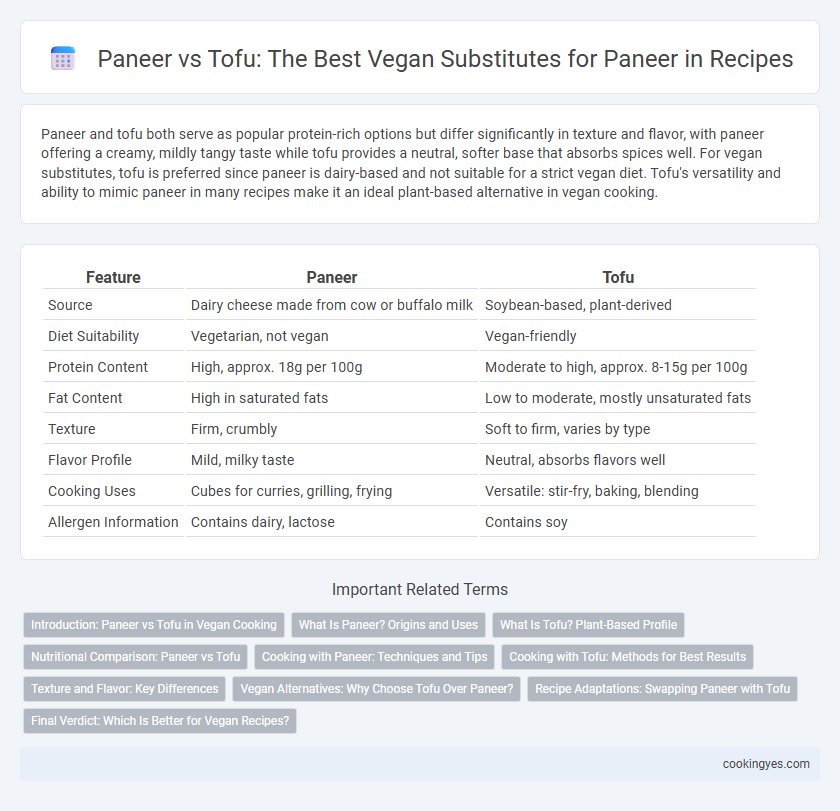Paneer and tofu both serve as popular protein-rich options but differ significantly in texture and flavor, with paneer offering a creamy, mildly tangy taste while tofu provides a neutral, softer base that absorbs spices well. For vegan substitutes, tofu is preferred since paneer is dairy-based and not suitable for a strict vegan diet. Tofu's versatility and ability to mimic paneer in many recipes make it an ideal plant-based alternative in vegan cooking.
Table of Comparison
| Feature | Paneer | Tofu |
|---|---|---|
| Source | Dairy cheese made from cow or buffalo milk | Soybean-based, plant-derived |
| Diet Suitability | Vegetarian, not vegan | Vegan-friendly |
| Protein Content | High, approx. 18g per 100g | Moderate to high, approx. 8-15g per 100g |
| Fat Content | High in saturated fats | Low to moderate, mostly unsaturated fats |
| Texture | Firm, crumbly | Soft to firm, varies by type |
| Flavor Profile | Mild, milky taste | Neutral, absorbs flavors well |
| Cooking Uses | Cubes for curries, grilling, frying | Versatile: stir-fry, baking, blending |
| Allergen Information | Contains dairy, lactose | Contains soy |
Introduction: Paneer vs Tofu in Vegan Cooking
Paneer and tofu are popular cheese and soy-based products often compared as vegan substitutes due to their similar texture and versatility in cooking. Paneer, a traditional Indian cheese made from milk, offers a rich, creamy taste but is not vegan, whereas tofu made from soybeans provides a neutral flavor, making it adaptable in various vegan recipes. Understanding their differences in origin, nutritional content, and culinary uses helps optimize choices for plant-based diets and vegan cooking applications.
What Is Paneer? Origins and Uses
Paneer, a fresh cheese integral to South Asian cuisine, is crafted by curdling heated milk with an acidic agent such as lemon juice or vinegar. Its mild, slightly tangy flavor and firm yet crumbly texture make it versatile for dishes like saag paneer, paneer tikka, and paneer bhurji. Unlike tofu, which is a soy-based vegan substitute, paneer is dairy-derived, making it unsuitable for vegans but cherished for its rich protein content and culinary adaptability in vegetarian diets.
What Is Tofu? Plant-Based Profile
Tofu, a versatile plant-based protein made from soybeans, serves as an excellent vegan substitute for paneer due to its neutral taste and firm texture. Rich in essential amino acids, calcium, and iron, tofu offers a nutrient-dense alternative suitable for lactose-intolerant and vegan diets. Its ability to absorb diverse flavors makes tofu ideal for replicating paneer's role in a variety of Indian and global dishes.
Nutritional Comparison: Paneer vs Tofu
Paneer contains higher protein and calcium levels compared to tofu, making it a nutrient-dense option for those seeking muscle maintenance and bone health. Tofu is lower in calories and fat, with beneficial isoflavones that support heart health and hormonal balance. Both provide essential nutrients, but tofu offers a cholesterol-free, vegan-friendly profile, while paneer contains saturated fat and is dairy-based.
Cooking with Paneer: Techniques and Tips
Paneer offers a firm texture and mild flavor that holds up well in grilling, frying, and simmering, making it a versatile substitute for tofu in many vegan recipes. Unlike tofu, paneer does not crumble easily, allowing for distinct cubes that retain shape during cooking, ideal for dishes like tikka or paneer butter masala. Marinating paneer enhances absorption of spices and improves flavor, while cooking at moderate heat prevents it from becoming rubbery.
Cooking with Tofu: Methods for Best Results
Cooking with tofu for vegan substitutes requires proper pressing to remove excess water, enhancing texture and flavor absorption. Marinating tofu before grilling, baking, or pan-frying helps mimic paneer's richness, while using firm or extra-firm tofu varieties ensures better structural integrity in dishes. Techniques like freezing and thawing tofu create a chewier consistency, making it a versatile paneer alternative in Indian-inspired recipes.
Texture and Flavor: Key Differences
Paneer offers a dense and crumbly texture with a mild, milky flavor that differs significantly from tofu's softer, spongy consistency and neutral taste. Tofu's ability to absorb surrounding flavors makes it versatile for vegan dishes, while paneer's distinct dairy flavor adds richness and creaminess to recipes. These textural and flavor contrasts are essential when choosing between paneer and tofu as vegan substitutes in culinary applications.
Vegan Alternatives: Why Choose Tofu Over Paneer?
Tofu, derived from soybeans, stands out as a superior vegan alternative to paneer due to its plant-based origins and rich protein content, making it suitable for vegan diets. Unlike paneer, which is dairy-based and unsuitable for vegans, tofu offers a versatile texture that absorbs flavors well in various cuisines. Its lower saturated fat content compared to paneer promotes heart health, aligning with vegan nutritional goals.
Recipe Adaptations: Swapping Paneer with Tofu
Tofu serves as an excellent vegan substitute for paneer in various recipes, offering a similar texture when pressed and cubed appropriately. Adjustments in seasoning and marination, such as adding nutritional yeast or a splash of lemon juice, can enhance tofu's flavor to mimic paneer's mild taste. Cooking methods like pan-frying or grilling tofu help maintain a firm texture, ensuring successful adaptations in dishes like palak paneer or paneer tikka.
Final Verdict: Which Is Better for Vegan Recipes?
Tofu is the superior choice for vegan recipes due to its plant-based origin, neutral flavor, and versatile texture that absorbs spices well, making it ideal for a variety of dishes. Paneer, being a dairy product, is unsuitable for strict vegan diets despite its similar texture and protein content. For those prioritizing ethical and dietary vegan standards, tofu consistently aligns better with plant-based culinary needs.
Paneer vs Tofu for Vegan Substitutes Infographic

 cookingyes.com
cookingyes.com